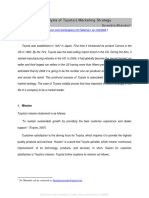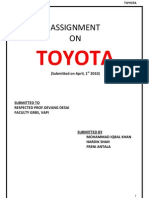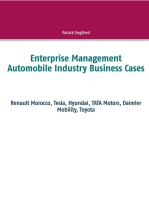Toyota
Toyota
Uploaded by
henockCopyright:
Available Formats
Toyota
Toyota
Uploaded by
henockOriginal Description:
Copyright
Available Formats
Share this document
Did you find this document useful?
Is this content inappropriate?
Copyright:
Available Formats
Toyota
Toyota
Uploaded by
henockCopyright:
Available Formats
Toyota
Toyota may have gotten its start in auto making by being a fast follower, but it is now the
innovator. In 1936, Toyota admitted following Chrysler’s landmark Airflow and patterning its
engine after a 1933 Chevrolet engine. But by 2000, when it introduced the first hybrid electric-
gasoline car, the Prius, Toyota was the leader. In 2002, when the second-generation Prius hit
showrooms, dealers received 10,000 orders before the car was even available; GM followed with
an announcement that it would enter the hybrid market with models of its own.
Toyota’s strategy for the Prius was to build an environmentally friendly car that reduced the
footprint on the environment by reducing energy consumption, greenhouse gas emission rates,
and smog emission rates. Toyota president Fujio Cho sees environmental performance as
essential to the future of cars.
Introducing such leading-edge products presents marketing challenges. For example, the
marketing messages must educate consumers that the Prius doesn’t need to be plugged in, as an
electric car does. The marketing messages must also communicate the value of fuel efficiency,
not just for fuel savings for customers, but for the environment as well. “Every gallon of gas
burned releases 20 pounds of carbon dioxide into the atmosphere. The general public still lags
in appreciating the global warming significance of that,” said Dave Hermance, executive
engineer for environmental engineering at Toyota’s Technical Center in Los Angeles.
Toyota offers a full line of cars for the U.S. market, from family sedans to sport utility vehicles
to trucks to minivans. Toyota also has products for different price points, from lower-cost Scions
to mid-priced Camrys to the luxury Lexus. Designing these different products means listening to
different customers, building the cars they want, and then crafting the marketing to reinforce
each make’s image. For example, Toyota spent four years carefully listening to teens before
launching the Scion for first-time car buyers. It learned, for instance, that Scion’s target age
group of 16- to 21-year-olds wanted personalization. To meet that preference, Toyota will build
the car mono-spec at the factory and let customers at dealerships choose from over 40
customization elements, from stereo components to wheels and even floor mats. Toyota markets
the Scion at music events and will have showrooms where “young people feel comfortable
hanging out and not a place where they just go stare at a car,” said Scion vice president Jim Letz.
In contrast, Toyota’s marketing strategy for the Lexus line focuses on perfection. The tagline for
the global strategy is “Passionate Pursuit of Perfection.” Dealerships offer white-glove treatment.
Toyota markets Lexus globally and understands that each country defines perfection differently.
In the United States, for example, perfection and luxury mean comfort, size, and dependability.
In Europe, luxury means attention to detail and brand heritage. Therefore, although the core of
Lexus marketing is similar (a consistent Lexus visual vocabulary, logo, font, and overall
communication), the advertising varies by country.
A big reason behind Toyota’s success is its manufacturing. Toyota’s combination of
manufacturing speed and flexibility is world class. Its plants can make as many as eight different
models at the same time, which brings Toyota huge increases in productivity and market
responsiveness. Toyota is in the midst of integrating its assembly plants around the world into a
single giant network. The plants will customize cars for local markets and be able to shift
production quickly to satisfy any surges in demand from markets worldwide. With a
manufacturing network, Toyota can build a wide variety of models much more inexpensively.
That means Toyota will be able to fill market niches as they emerge without having to build
whole new assembly operations. “If there’s a market or market segment where they aren’t
present, they go there,” said Tatsuo Yoshida, auto analyst at Deutsche Securities Ltd. And with
consumers increasingly fickle about what they want in a car, such market agility gives Toyota a
huge competitive edge.
Toyota’s sales rose in every region of the world in 2003, and the company earned $146 billion. It
edged past Ford Motor Co., to become the world’s second-largest carmaker, and its market cap
of $110 billion is more than that of GM, Ford, and DaimlerChrysler combined. Toyota is now
eyeing the top spot, with a goal of surpassing GM as the world’s largest carmaker by 2010.
Discussion Questions
1. What have been the key success factors for Toyota?
2. Where is Toyota vulnerable? What should it watch out for?
3. What recommendations would you make to senior marketing executives going forward?
What should they be sure to do with its marketing?
You might also like
- Project Report On Totota Kirloskar MotorDocument61 pagesProject Report On Totota Kirloskar MotorRavi Chandra M44% (9)
- Case Study On Toyota's Globalization StrategiesDocument5 pagesCase Study On Toyota's Globalization StrategiesPranav SehgalNo ratings yet
- Prius That Shook WorldDocument388 pagesPrius That Shook Worldnijnt100% (1)
- How Toyota Became #1 (Review and Analysis of Magee's Book)From EverandHow Toyota Became #1 (Review and Analysis of Magee's Book)No ratings yet
- Market Strategies of ToyotaDocument39 pagesMarket Strategies of ToyotaSaqib Ashraf100% (1)
- Assignment On ToyotaDocument39 pagesAssignment On ToyotaMohammad Iqbal Khan80% (40)
- Hino Dutro Ranger Profia EnginesDocument2 pagesHino Dutro Ranger Profia Enginesmei jonie83% (12)
- 9-5 Aero HirschDocument2 pages9-5 Aero Hirschajjyt100% (1)
- Garuda Boarding PassDocument1 pageGaruda Boarding PassRaditya JuliantoroNo ratings yet
- 80Z7 Chassis Part1Document212 pages80Z7 Chassis Part1ssinokrotNo ratings yet
- Case Analysis On Toyota CompanyDocument2 pagesCase Analysis On Toyota CompanyEng. Tadele DandenaNo ratings yet
- Toyota Case StydyDocument6 pagesToyota Case Stydytom agazhieNo ratings yet
- Case Study ToyotaDocument6 pagesCase Study ToyotaMonaMussaNo ratings yet
- An Analysis of Toyota's Marketing StrategyDocument14 pagesAn Analysis of Toyota's Marketing Strategysaddam89No ratings yet
- Toyota Case StudyDocument8 pagesToyota Case Studyshivam dubey100% (1)
- Case Study ToyotaDocument6 pagesCase Study ToyotaManish GuptaNo ratings yet
- Final - Project Toyota ShanuDocument47 pagesFinal - Project Toyota ShanuShanu SatheesanNo ratings yet
- Toyota: By, Senthil PrabhuDocument9 pagesToyota: By, Senthil PrabhusenthilmbacaNo ratings yet
- Toyota CaseDocument2 pagesToyota CaseMyo Kyaw SwarNo ratings yet
- Toyota ProjectDocument9 pagesToyota ProjectMohemmad NaseefNo ratings yet
- POM ToyotaDocument28 pagesPOM ToyotaLit Yen YeongNo ratings yet
- Case 01: MBA 506 (Marketing Management)Document2 pagesCase 01: MBA 506 (Marketing Management)sanzida akterNo ratings yet
- TOYOTADocument8 pagesTOYOTASyeda Anny Kazmi100% (3)
- The Americanization of ToyotaDocument7 pagesThe Americanization of ToyotaAnil SinghNo ratings yet
- SWOT Analysis Toyota: StrengthsDocument2 pagesSWOT Analysis Toyota: StrengthsSachin ShahNo ratings yet
- Toyota Corolla Marketing Plan Authentic..Document8 pagesToyota Corolla Marketing Plan Authentic..Omair MunawarNo ratings yet
- Project Report On Totota Kirloskar Motor by Piyush PrasannaDocument64 pagesProject Report On Totota Kirloskar Motor by Piyush PrasannaPiyush Singh Prasanna100% (3)
- Case Study ToyotaDocument3 pagesCase Study ToyotaHà TrầnNo ratings yet
- Toyota Paper ResearchDocument9 pagesToyota Paper ResearchBuddhi ShuddhiNo ratings yet
- Toyota PriusDocument4 pagesToyota Priusnitin$No ratings yet
- Car Brand Automobile Industry in The Porte's MatrixDocument5 pagesCar Brand Automobile Industry in The Porte's MatrixAli IsmailNo ratings yet
- Industry ProfileDocument20 pagesIndustry ProfileShanu shriNo ratings yet
- Assignment On Toyota - Pdf.nehaDocument39 pagesAssignment On Toyota - Pdf.nehavicky_ab9999100% (1)
- Micro Environment Macro Environment Market Research Consumer Behaviour Swot Analysis Market Segmentation 4P RecommendationDocument43 pagesMicro Environment Macro Environment Market Research Consumer Behaviour Swot Analysis Market Segmentation 4P RecommendationAbdulla RasheedNo ratings yet
- Toyota's Marketing StrategyDocument14 pagesToyota's Marketing StrategyLavin Gurnani0% (1)
- Prius Case Study Final VersionDocument18 pagesPrius Case Study Final VersionJustine Deregnaucourt100% (7)
- Project Report On Totota Kirloskar MotorDocument61 pagesProject Report On Totota Kirloskar MotorManthesh Krishna100% (1)
- Toyota IncidentDocument6 pagesToyota IncidentPhạm GiaoNo ratings yet
- Course Project Assignment Part 2Document12 pagesCourse Project Assignment Part 2thelowngeNo ratings yet
- Toyota: SWOT Analysis, BCG Matrix: Strategy of Toyota Growth StrategyDocument4 pagesToyota: SWOT Analysis, BCG Matrix: Strategy of Toyota Growth StrategyUmar AsgharNo ratings yet
- Latin America - Nano LaunchDocument4 pagesLatin America - Nano LaunchSarjeet KaushikNo ratings yet
- 170 - Toyota MotorsDocument4 pages170 - Toyota MotorsMartin Alviar Belascuain100% (1)
- AutomobileDocument98 pagesAutomobilesrp188No ratings yet
- Toyota: A Global Auto Manufacturer (Facility Decisions)Document2 pagesToyota: A Global Auto Manufacturer (Facility Decisions)Tamizh pariNo ratings yet
- MM Term Paper 01 Spring 2023Document3 pagesMM Term Paper 01 Spring 2023Fahim Ahmed YeaminNo ratings yet
- Prius Die de Wereld Deed SchuddenDocument105 pagesPrius Die de Wereld Deed Schuddenren_nguyen100% (1)
- POSITIONING ANALYSIS Toyota Motor CorporationDocument6 pagesPOSITIONING ANALYSIS Toyota Motor Corporationbonnyjohn50% (2)
- Consumer Buying Motives of ToyotaDocument39 pagesConsumer Buying Motives of ToyotaSanket Pingale100% (1)
- ToyotaDocument22 pagesToyotavidhi_bharatinfraNo ratings yet
- Bbim4103 International Marketing-1Document18 pagesBbim4103 International Marketing-1y kahyinNo ratings yet
- Economics Case StudyDocument28 pagesEconomics Case StudyZehra KHanNo ratings yet
- Toyota's: Globalization StrategiesDocument25 pagesToyota's: Globalization StrategiesitsgouravaroraNo ratings yet
- Toyota Motor Corporatio1Document5 pagesToyota Motor Corporatio1SammarsainiNo ratings yet
- New Microsoft Word DocumentDocument5 pagesNew Microsoft Word Documentrajmv7No ratings yet
- BRM ProjectDocument39 pagesBRM ProjectÑagáşaï BøïnâNo ratings yet
- ToyatoDocument20 pagesToyato2lavanya03No ratings yet
- Case 1: TOYOTA PRIUS: Leading A Wave of HybridsDocument8 pagesCase 1: TOYOTA PRIUS: Leading A Wave of HybridsDon CoralesNo ratings yet
- Tejano 07 Task PerformanceDocument2 pagesTejano 07 Task PerformanceEdlyn TejanoNo ratings yet
- Project Genesis It Was A Plan by The Toyota Motor Sales USA To Attract More Youthful Buyers To The Company'sDocument4 pagesProject Genesis It Was A Plan by The Toyota Motor Sales USA To Attract More Youthful Buyers To The Company'sPayalAgarwalNo ratings yet
- Honda Motor (Review and Analysis of Sakiya's Book)From EverandHonda Motor (Review and Analysis of Sakiya's Book)Rating: 2 out of 5 stars2/5 (1)
- Enterprise Management Automobile Industry Business Cases: Renault Morocco, Tesla, Hyundai, TATA Motors, Daimler Mobility, ToyotaFrom EverandEnterprise Management Automobile Industry Business Cases: Renault Morocco, Tesla, Hyundai, TATA Motors, Daimler Mobility, ToyotaNo ratings yet
- Reading 1, Pp. 1-20Document20 pagesReading 1, Pp. 1-20henockNo ratings yet
- Saint Mary's University: Chapter FiveDocument63 pagesSaint Mary's University: Chapter FivehenockNo ratings yet
- Draft Presentation SlideDocument19 pagesDraft Presentation SlidehenockNo ratings yet
- Krispy KremeDocument2 pagesKrispy KremehenockNo ratings yet
- ASPEN Flying Club: Student Pilot Solo Restrictions/LimitationsDocument1 pageASPEN Flying Club: Student Pilot Solo Restrictions/LimitationsPeter HuntNo ratings yet
- To Do So. No Certificate Should Be Extended For A Period Longer Than Three Months, and A ShipDocument2 pagesTo Do So. No Certificate Should Be Extended For A Period Longer Than Three Months, and A Shiphimansh1990No ratings yet
- DDC-SVC-BRO-0118 - Jun2020 DETROIT DIESEL TRANSMISIONESDocument22 pagesDDC-SVC-BRO-0118 - Jun2020 DETROIT DIESEL TRANSMISIONESangel017100% (1)
- Samba Visa Platinum Credit Cardholders Airport LoungesDocument4 pagesSamba Visa Platinum Credit Cardholders Airport LoungesalbaraamehdarNo ratings yet
- Steel Bridge - Bangalore PDFDocument13 pagesSteel Bridge - Bangalore PDFAbitha George ThomasNo ratings yet
- R5 Technology As A Way of RevealingDocument2 pagesR5 Technology As A Way of RevealingAngelica AgcaoiliNo ratings yet
- 2022 Nissan Kicks Owner ManualDocument564 pages2022 Nissan Kicks Owner ManualtratidaNo ratings yet
- Advantages & Disadvantages of Different Types of TransportDocument2 pagesAdvantages & Disadvantages of Different Types of TransportnassimosNo ratings yet
- Time Distance 1Document13 pagesTime Distance 1brave playerNo ratings yet
- Freshman Seminar: The Art and Science of Motorcycle DesignDocument48 pagesFreshman Seminar: The Art and Science of Motorcycle DesignAJAYYKKNo ratings yet
- Corvette LawsuitDocument50 pagesCorvette LawsuitGizmodo EditNo ratings yet
- Car Model Explanation With CriteriaDocument13 pagesCar Model Explanation With CriteriaarcgisNo ratings yet
- Form 4Document3 pagesForm 4Baljeet SinghNo ratings yet
- 15 Causes of Delays During Construction Phase of Road ProjectsDocument11 pages15 Causes of Delays During Construction Phase of Road Projectsemer_quezon100% (1)
- Overview of System Components For Dynamic Seat (DS) PDFDocument1 pageOverview of System Components For Dynamic Seat (DS) PDFMaksNo ratings yet
- Team-BHP PDI Checklist PDFDocument3 pagesTeam-BHP PDI Checklist PDFSNo ratings yet
- Lit MotorsDocument15 pagesLit MotorsAbhishek ChoudharyNo ratings yet
- 4 Instrument Cluster 10: 2004 Escape (204) Owners Guide (Post-2002-Fmt) USA English (Fus)Document256 pages4 Instrument Cluster 10: 2004 Escape (204) Owners Guide (Post-2002-Fmt) USA English (Fus)Mky Dos Santos Francisco FranciscoNo ratings yet
- Aceites VenolDocument4 pagesAceites VenolpedretapiNo ratings yet
- Logistics FedexDocument20 pagesLogistics FedexNehaNo ratings yet
- BAJA SAEINDIA 2019 Innovation AbstractDocument3 pagesBAJA SAEINDIA 2019 Innovation Abstractchanchalv_678018469No ratings yet
- Flimora Serial KeyDocument1 pageFlimora Serial KeyMadhukar Xenon49% (76)
- Time StudyDocument341 pagesTime StudyrasheamNo ratings yet
- EVolve Bermuda Public Engagement ReportDocument20 pagesEVolve Bermuda Public Engagement ReportBernewsAdminNo ratings yet
- UBC SkyTrain Extension Staff Presentation To CouncilDocument21 pagesUBC SkyTrain Extension Staff Presentation To CouncilCTV VancouverNo ratings yet
- New Beetle Anti-Lock Brake SystemDocument261 pagesNew Beetle Anti-Lock Brake SystemPKDNo ratings yet





























































































